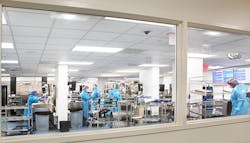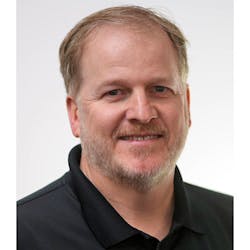Keeping sterile processing procedures primed and pumped
Improving processes consistently remains a goal in professional environments, and in the healthcare sterile processing arena it can mean the difference between patients making a complete recovery or contracting infections – even life or death. What are we doing and how can we do it better for the benefit of the patient and the organization at large? There are numerous devices, products, services, and technologies that enable Central Service/Sterile Processing & Distribution (CS/SPD) departments to clean, disinfect, sterilize and prep devices and instruments for the surgical team.
Healthcare Purchasing News spoke with four industry professionals who gave their insights on what they think are the most important topics, challenges, and upgrades in sterile processing right now.
Avoid recontamination, use sterile water!
Water is all around us. It is essential to the survival of all living beings. It is also important in sterilization. Without sterile water, medical instruments are at risk of recontamination due to water-borne pathogens. Many of the steps in reprocessing include water. “In practice, medical devices are immersed, rinsed, or sprayed with water or solutions with surfactants to prevent the dirt from drying out," according to a HPN continuing education article.1 Both the Centers for Disease Control and Prevention (CDC) and The Joint Commission recommend that facilities have a water risk management program in place. Patients are exposed to water directly, by ingestion, by inhalation of aerosols dispersed from water sources, by aspiration and by indirect contact from improperly reprocessed medical devices.2
The CDC has a Water Infection Control Risk Assessment (WICRA) for Healthcare Settings tool and recommends the following steps for evaluating the water in health facilities:
- Identify the areas that need to be assessed.
- Determine the likely water sources in the facility.
- Break down the likely modes of transmission for water-associated pathogens.
- Classify the patient’s vulnerability for each water source.
- Distinguish patient exposure.
- Evaluate current levels of preparedness in your Water Management Program.
- Calculate the total risk score by multiplying the numbers in each column.
- Rank the total risk scores by location and across the facility.
“Performing a WICRA using this tool will generate numerical scores of perceived risk, which can assist in prioritizing WMP activities such as monitoring and mitigation efforts. Total risk scores are intended for internal prioritization and do not hold significance outside the context of each site-specific WMP. Typically, the risks with highest scores will be used for priority focus, though some with lower scores may be given special consideration (e.g., mitigation can be quickly and easily implemented). Specific risk management actions should be determined in accordance with WMP activities,” according to the CDC.2
Water quality and how it affects equipment performance, patient safety and surgical capacity is one of the biggest challenges in Sterile Processing Departments right now, according to Paquet. “There is currently a substantial knowledge gap that requires educating facilities, engineers and SPD staff of the importance of and how to achieve the water quality standards needed to assure patient safety and compliance with AAMI TIR34 and ST79 guidelines. Comprehensive water quality systems and services that address all aspects of customer water quality issues are a solution that provides the best strategy to success,” he said.
Just do it … right
The main priority of CS/SPD departments remains reducing risks and increasing safety for patients and staff.
To achieve highest standards, SPD technicians need common sense and a willingness to do the job right, according to Paquet, mmic. “Fostering an environment that values investment in the SPD staff through continuing education is key with good follow-on supervision to alleviate any areas of confusion about best practices in performing the duties of their jobs. A culture of excellence needs to be established by staff leadership so there is an awareness of the importance of doing their job right and how it has a direct impact on patient outcomes,” he emphasized.
Products that increase department capacity by reducing the amount of time for work to flow through the department improve workflow in CS/SPD Departments, Paquet said. “Products or strategies that reduce staff and instrument movement, eliminate build-up of work in process and eliminate defects will provide the best return on investment. Having meaningful process metrics and the ability to collect process data will support the quality management process and support continuous improvement efforts to improve workflow.”
“The biggest challenge in my opinion is developing new leadership as part of a succession plan for leadership that is nearing retirement, being promoted, and or leaving the field all together. The ability to clearly articulate what’s expected of leadership outside of hard skills has room for improvement. There are opportunities for success in finding more effective ways to translate the interpersonal leadership skills necessary in this area,” Cruz said.
Playing clinical catch-up
COVID-19 has put a damper on many things, especially elective surgery. As cases of COVID-19 are currently waning, hospitals are catching up on the surgeries they had to postpone and the demand on Sterile Processing Departments is even more than it already was.
“The pandemic has created a substantial backlog for surgery and focus is now being re-directed to elective surgical schedules which is creating a higher demand for SPDs to process even more surgical instruments,” mmic’s Paquet noted. “There is an increased awareness of the mission of infection control and the role sterile processing plays in the patient safety mission. The focus is now even more directed to the safety of processed instruments since the pandemic. Patient safety is top of mind,” he said.
Another thing that health facilities are catching up on post-COVID is cancer screenings. According to an article published by Wiley, cancer deaths are expected to increase due to a shortfall of screenings.3
“Cancer screening rates are still lower than pre-pandemic levels, but the healthcare community is trying to counter that issue.4 If their efforts are successful and people become more comfortable returning for non-critical procedures, there may be a return to pre-COVID cancer screening rates or, if there is a ‘catch-up’ effect, possibly higher than pre-COVID rates. As there are staffing shortages in some regions, this may present a challenge for cleaning and sterilization departments, making automation, such as drying cabinets and automated endoscope reprocessors (AERs) more important,” Benedict said.
Navigating the space race
“The typical response is to move to a track system. While in the end that may be needed, there is a lot of waste that can be found in existing setups. Two areas we have helped customers are in the individual shelving units, as well as the cart staging area. Many shelving systems were installed years ago with 5-6 shelves. If you look at these systems, you’ll see stacked packs (not recommended for wrapped packs) with a lot of unutilized space above. Adjusting these shelves down to fill these voids will create the opportunity for more storage levels to be added,” Salus recommended.
“The other area is the case cart staging area,” he continued. “A lot of floor space is dedicated to this temporary storage need, leaving that area totally unusable for storage. We have created opportunities to utilize that space for storage, without giving up on the needed staging area. By creating parking spots, under our shelving, the vertical space above the case cart can be reclaimed for storage, the physical space freed up can be used for additional storage or added prep stations. These creative ideas for space utilization can provide the CSPD the space they need to keep up with surgical case volumes,” he said.
Placing endoscope processing under microscope
The Association for the Advancement of Medical Instrumentation (AAMI) recently updated its ST91:2021 Standard for Flexible and Semi-Rigid Endoscope Processing. This has caused increased interest in topics like endoscope drying, according to Benedict, Olympus. “We’re seeing an uptick in people asking about endoscope drying, air quality to use while drying and other quality assurance measures that are recommended in this standard,” she said. The Olympus ChanIDry Endoscope Drying cabinet dries and stores endoscopes and assists customers in meeting the new recommendations for endoscope drying, Benedict told HPN. “Facilities can supply their own air, or an optional compressor solution can be provided.”
Cruz, PRETREAT CSS, offers another perspective. “I see a lot of discussion in high-level disinfection and whether or not it would be safer for patients to use single-use disposable scopes. I’d like to see more of the discussion focus on the environmental impact of that single-use scope, and even challenge these companies to begin a recycle program for them. I wonder if this discussion could be avoided if more effective scope designs were created with reprocessing in mind, but that would require companies to resubmit 510ks and completely overhaul the design of their scopes, which may weigh heavily on their functionality,” she said.
SPD essentialness and necessity
Paquet, mmic, and Cruz, PRETREAT CSS, both emphasize the importance of Sterile Processing and lament that this department is often glossed over.
“The importance of the Sterile Processing Department is often overlooked in healthcare. In many hospitals it is the largest cost center and has the largest impact on capacity and scheduling in the operating rooms. Lack of attention and investment in these departments by decision makers is negatively impacting the cost of healthcare,” Paquet said.
The immense workload that is being dumped on CS/SPD workers is enough to cause burnout, not to mention that many of these professionals don’t feel valid in their jobs. CS/SPD professionals are finally starting to gain the recognition they deserve post-COVID. “I have seen a large empowerment to our profession considering that our standard practices were adopted and brought real validity to our job as a profession amongst the healthcare industry. On the other hand, I see a lot of department burnout. Especially when furloughs and layoffs happen, the importance of someone’s profession was truly brought into question. That they could just simply release them of their duties because they may not have understood the purpose of the SP professionals’ job responsibilities and impact on patient safety,” Cruz said.
Technology upgrades that have been occurring over the past decade have improved and changed workflow in many professions. In some, it has even replaced workers. Will machines take over CS/SPD?
Machines may better process, but they will not replace CS/SPD workers, according to Cruz. “I personally love the new automation systems coming out. Alleviating technicians from busy work to allow them to strive in what only they can do. For example, the machine that will string instrumentation and automatically fill out the pick list as the professional has completed quality, cleanliness and functionality inspections. I am not fearful of our job going to the robots, dare I say, because there are certain aspects that only we can achieve.”
SPD Resource Guide Vendor - Listings by Product Category
References - Healthcare Purchasing News. Water for cleaning medical devices. https://www.hpnonline.com/continuingeducation/article/21253287/water-for-cleaning-medical-devices. Accessed April 1, 2022.
- Centers for Disease Control and Prevention. Water Infection Control Risk Assessment (WICRA) for Healthcare Settings. https://www.cdc.gov/hai/pdfs/prevent/water-assessment-tool-508.pdf). Accessed April 1, 2022.
- American Cancer Society. Journals, Cancer. A national quality improvement study identifying and addressing cancer screening deficits due to the COVID-19 pandemic. https://acsjournals.onlinelibrary.wiley.com/doi/10.1002/cncr.34157. Accessed April 1, 2022.
- Joung, RH, Nelson, H, Mullett, TW, Kurtzman, SH, Shafir, S, Harris, JB, Yao, KA, Brajcich, BC, Bilimoria, KY, Cance, WG. A national quality improvement study identifying and addressing cancer screening deficits due to the COVID-19 pandemic. Cancer. 2022. https://doi.org/10.1002/cncr.3415. Provided by Olympus Corporation of the Americas.
About the Author
Erin Brady
Assistant Editor
Erin Brady is Assistant Editor for Healthcare Purchasing News, an Endeavor Business Media publication.





